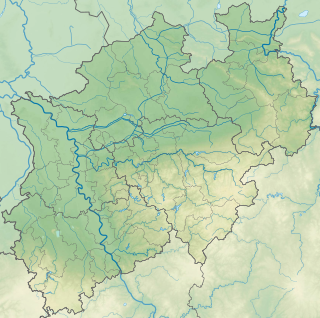Sülz plateau
| Sülz plateau | |||
|---|---|---|---|
| Systematics according to | Handbook of the natural spatial structure of Germany | ||
| Greater region 1st order | Low mountain range threshold | ||
| Greater region 2nd order | Rhenish Slate Mountains | ||
| Main unit group | 33 → Süderbergland |
||
| About main unit | 338 → Bergische plateaus |
||
| 4th order region (main unit) |
338.4 → Agger-Sülz plateaus |
||
| Natural space |
338.41 → Sülz plateau |
||
| Geographical location | |||
| Coordinates | 50 ° 57 '21 " N , 7 ° 13' 57" E | ||
|
|||
| local community | Overath , Rösrath , Bergisch Gladbach | ||
| state | North Rhine-Westphalia | ||
| Country | Germany | ||
The Sülzhochfläche is, according to the Handbook of the Natural Region Divisions of Germany a natural spatial unit with the order number 338.41 and is one of the superior natural environment 338.4 ( Agger-Sülz-plateaus ). It covers large parts of the Overath urban area with the Heiligenhaus district in the center of the natural area, the southeast of Bergisch Gladbach beyond Herkenrath around the Herweg district , the northeast of Rösrath around the Bleifeld district and the extreme north of Lohmar around the Dahlhaus district . The extreme northeastern tip of the Königsforst is also located in the natural area.
The Sülz plateau borders in the north on the Paffrather Kalkmulde (order number 338.23), on the Bärbroicher Höhe (338.224) and the Sülzsenken and ridge (338.225), in the southeast on the Overather Aggertal (338.42), in the south on the Scheiderhöhe (338.60) and in the west to the Bensberg-Forsbacher mountain edge (338.40).
It is a plateau that has a height of 200 to 250 m and is sharply delimited in the southeast by the deeply cut valley of the Agger and in the south by the route of the Aggertalbahn . In the north, the valleys of the Velbach and one of its tributaries mark the edge of the plateau. The valley of the middle Sülz , which cuts the Sülz plateau into two parts, is also cut deep . As a single elevation, the Lüderich protrudes from the plateau in the southwest as an ore-containing hardened ridge . In the area of the Sülztal north of Lüderich, galena and zinc blende have been mined since the 15th century ; in the second half of the 20th century, the deposits contributed almost 10% of the zinc mining in West Germany. The lead-zinc deposits in the Bensberg ore district are linked to faults in which the Bensberg red slate rocks are separated from the Grauwacken . Other mines and heaps between Moitzfeld and Immekeppel or near Herkenrath point to the extensive former mining activities on the Sülz plateau.
The agricultural and forestry use of the plateau can be divided into two areas. East of Bensberg to the Sülztal or north of Heiligenhaus and in the Schmitzhöhe area , the soils show weakly alkaline brown earths and parabrown earths , which allow intensive use as agricultural land. Otherwise, high forests of coniferous and deciduous trees predominate.
